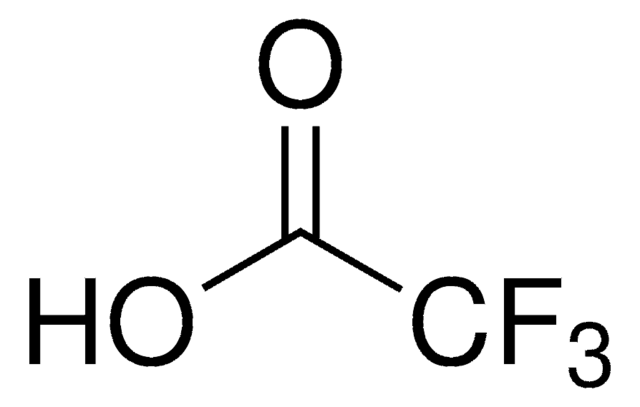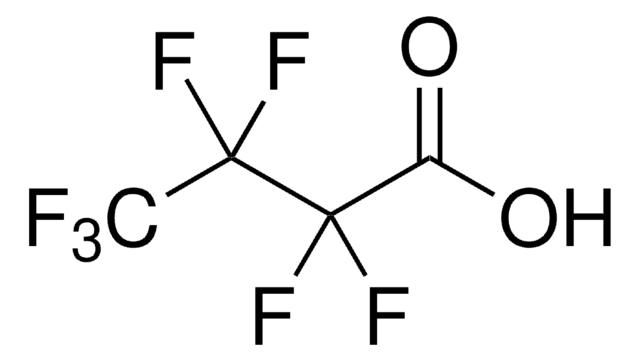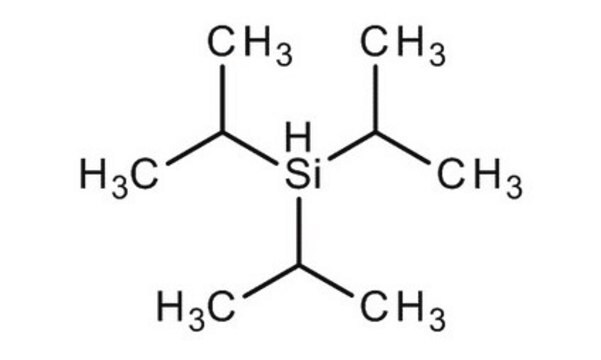8.08260
Acido trifluoroacetico
for synthesis
Sinonimo/i:
TFA
About This Item
Prodotti consigliati
Densità del vapore
3.9 (vs air)
Livello qualitativo
Tensione di vapore
97.5 mmHg ( 20 °C)
Saggio
≥99% (acidimetric)
Forma fisica
liquid
Indice di rifrazione
n20/D 1.3 (lit.)
pH
1 (10 g/L in H2O)
P. eboll.
72.4 °C (lit.)
Punto di fusione
−15.4 °C (lit.)
Solubilità
soluble 10 g/mL
Densità
1.489 g/mL at 20 °C (lit.)
Temperatura di conservazione
2-30°C
Stringa SMILE
OC(C(F)(F)F)=O
InChI
1S/C2HF3O2/c3-2(4,5)1(6)7/h(H,6,7)
DTQVDTLACAAQTR-UHFFFAOYSA-N
Cerchi prodotti simili? Visita Guida al confronto tra prodotti
Descrizione generale
Applicazioni
- In the direct conversion of cyclohexanone to caprolactam using acetonitrile as the additive.
- In the synthesis of 1,2,4,5-tetrasubstituted imidazoles by four-component condensation of benzil, aldehydes, amines, and ammonium acetate.
- In the synthesis of d-α-Tterpineo from d-limonene by Markovnikov addition followed by hydrolysis.
Caratteristiche e vantaggi
- High acidity
- Easy elimination
- Good solubility in organic solvent and in water.
Risultati analitici
Density (d 20 °C/ 4 °C): 1.487 - 1.490
Identity (IR): passes test
Avvertenze
Danger
Indicazioni di pericolo
Classi di pericolo
Acute Tox. 4 Inhalation - Aquatic Chronic 3 - Eye Dam. 1 - Skin Corr. 1A
Codice della classe di stoccaggio
8A - Combustible corrosive hazardous materials
Classe di pericolosità dell'acqua (WGK)
WGK 2
Punto d’infiammabilità (°F)
>212.0 °F - Pensky-Martens closed cup
Punto d’infiammabilità (°C)
> 100 °C - Pensky-Martens closed cup
Certificati d'analisi (COA)
Cerca il Certificati d'analisi (COA) digitando il numero di lotto/batch corrispondente. I numeri di lotto o di batch sono stampati sull'etichetta dei prodotti dopo la parola ‘Lotto’ o ‘Batch’.
Possiedi già questo prodotto?
I documenti relativi ai prodotti acquistati recentemente sono disponibili nell’Archivio dei documenti.
I clienti hanno visto anche
Contenuto correlato
Fmoc resin cleavage and deprotection follows the difficult task of detaching the peptide from the resin support and removing all the side-chain protecting groups of the amino acid residues to yield the desired peptide.
Il team dei nostri ricercatori vanta grande esperienza in tutte le aree della ricerca quali Life Science, scienza dei materiali, sintesi chimica, cromatografia, discipline analitiche, ecc..
Contatta l'Assistenza Tecnica.






